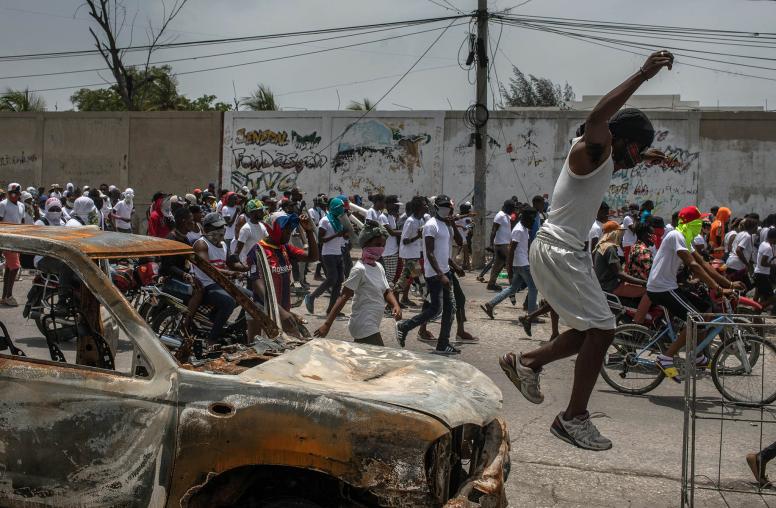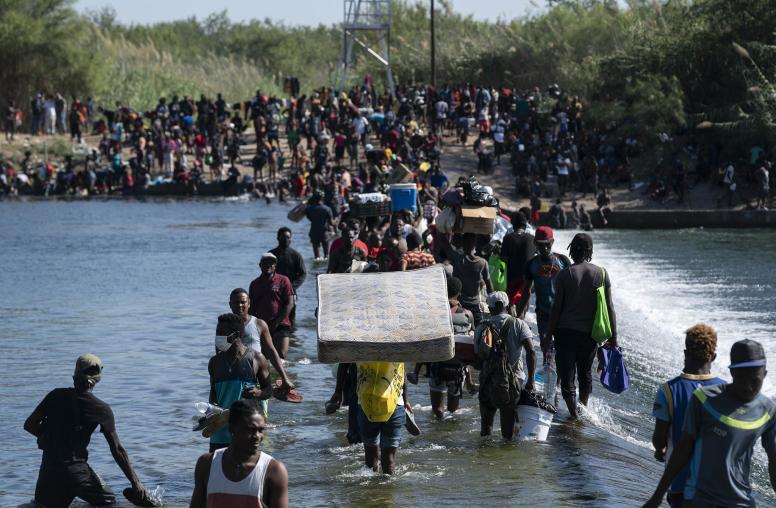For Peace in Haiti, Let’s Build on the Success We’re Ignoring
Haiti’s Dr. Marie-Marcelle Deschamps: ‘The world can help us bring peace by allying with the people.’
Haiti’s new eruption of violence threatens anarchy and famine for its 11 million people and endangers security in the entire region, yet “an old narrative that ‘Haiti is hopeless’” risks deterring U.S and international policymakers from any real effort to help, says Marie-Marcelle Deschamps, an internationally recognized Haitian doctor and humanitarian. “The world is hesitating, and thus isolating Haiti, but this ignores many successful ways that Haitians and international partners have built progress and peace together,” Deschamps said in an interview. “Haitians will support a proper restoration of security, which is our urgent first step now.”

Years of deadlock among political elites has paralyzed constitutional governance, allowing criminals and street gangs, armed mainly with guns from the United States, to seize most of the capital, Port-au-Prince. Gang violence has overmatched Haiti’s police, closing or shattering airports, ports, hospitals and commerce. “Haitians are dying every day because of international inaction,” said Deschamps, who is in Miami, trying to return to her country. “Every day, I get calls from my fellow Haitians about the desperation for food, water and medical help just to survive.” More than 300,000 people have fled their homes in recent weeks and half of Haitians, more than 5 million people, now need humanitarian assistance.
Deschamps, a women’s health and infectious disease specialist, helps lead what seems like a miracle amid Haiti’s decades of upheaval — a medical center called GHESKIO that provides medical care to impoverished Haitians and has led in international efforts to combat COVID, AIDS, cholera and other diseases. Far beyond traditional medical care, Deschamps has led in building services — food supplies, sanitation help, employment, schools and scholarships — that help marginalized women, children and families build secure lives and opportunity for their futures. As Haiti’s violence halted travel to the country this month, Deschamps was in Washington to meet U.S. officials and be recognized as a finalist for USIP’s 2023 Women Building Peace Award.
Deschamps underscores the concerns of USIP experts and other analysts that the United States and the global community risk a humanitarian and security catastrophe by letting Haiti collapse. This threatens “more intense waves of migration; unleashed human, weapons and drugs trafficking in the Caribbean; and a level of human suffering rarely seen on this side of the planet,” USIP analysts warned this month. “The Haitian people themselves want to rebuild security first, and then rebuild our futures in our beautiful homeland,” Deschamps said. “But we need an American and international partnership that allies itself with the Haitian population.”
International responses to past crises have leaned too heavily on foreign nations’ ideas, “have not allowed Haitians to decide on their own what needs to be done” and have tended to undermine, rather than strengthen, civil society, Haitian-American political scientist Francois Pierre-Louis told the Associated Press recently.
Doctor Deschamps, you say that the world has given up on Haiti, ignoring successes in building peace and development. What would you point to as a big success, and why was it successful?
Anyone looking for success in Haiti should look at Haitians’ advances in health and medical care achieved through true partnerships with international supporters. One case is the work of our GHESKIO medical centers, which get support from partnerships with civil society groups and universities in the United States. We have built this broad medical system, treating more than 100,000 patients a year, training tens of thousands of health care workers, and we are advancing research on infectious diseases like AIDS. At our small scale, we apply our public health model to helping our neighbors and communities solve wider problems by providing schools, scholarships and essential services to women, children and families. Women are the backbone of Haitian families and our country’s entire social fabric.
But the huge example is the U.S. government’s successful PEPFAR program to help Haiti, like other countries, build global capacities against HIV/AIDS and save millions of lives — many of them in my country. This is a Haitian-American success story! Assistance programs like PEPFAR work very well when they are designed for the situation on the ground in a given country. This means including local partners in shaping that design. When I say “partners,” I don’t mean only the government bureaucracy, but also the private sector and the civil society groups working for the public welfare. Another essential is to keep everything transparent — the decision-making processes, the flow of money. And third is to make sure that assistance programs are developing the capacities of the local government and civil society to handle the problem. PEPFAR has done these things!
If governments or organizations internationally are feeling that Haiti is hopeless, they should check the design and accomplishments in Haiti of America’s PEPFAR program. And we can apply that model to improving Haiti’s capacities in education, in security and other areas. This is the approach that can help Haiti stabilize and become a valuable partner, rather than a security danger, for its neighbors.
So let’s say that PEPFAR offers a model for helping Haiti. The immediate problem is perhaps Haiti’s worst violent crisis in decades, which may make it difficult for some in the international community to see how to begin.
Yes, of course, we need to establish security first, before we can achieve anything else. But we can be successful here, too! The violence is coming from local gangs that seem powerful only because they have guns, and they have many younger men and women who are desperate because they can find no path to a successful life through education or jobs. But the gangs are strong only against the helpless.
Haitians’ experience tells us that establishing security depends on quality more than quantity. It doesn’t need some huge intervention. In fact, if some large security force came, but was not good at communicating and cooperating with Haitians on the community and neighborhood levels, this would only prolong the problem. Haitians feel that we need a smaller effort that is of good quality, that is prepared to communicate broadly, including the local community leaderships and the civil society institutions. It must protect the population and work as a partner with the whole of society.
It must protect the population and work as a partner with the whole of society.
Once the security emergency is stabilized, the way to success is to quickly begin steps that let people see the intervention’s benefits. That is, a shift from the security priority to a wholistic strategy that improves lives. That wholistic strategy must let people see actual improvements in their lives — job opportunities, education and basic services. It must be a long-term partnership, as the PEPFAR program has been, to yield results. [The United States last year announced a 10-year strategic plan to promote stability in Haiti, one of nine countries where it is launching such efforts.]
Those who are afraid to help Haiti in this crisis will cite the long pattern of crises — and failed international interventions — reaching back 30-plus years. What can be done differently this time to be successful?
So many times, when the world came to try to help Haiti, the essential failure was that it partnered only with elites or the state bureaucracy, and excluded civil society and organizations working on the ground for the public good. The world can help us bring peace by allying with the people, and with those who are working entirely for the people’s well-being. A huge example in Haiti is the church, which is deeply connected with people and communities. Another is the Albert Schweitzer Hospital in Deschapelles. Representatives of these kinds of organizations must be part of shaping interventions and solutions.
Every conversation with my Haitian colleagues and neighbors and networks tells me that Haitians are eager to cooperate with a security program that will stop the gangs and prioritize safety for ordinary people. I am convinced that together we can make these changes! Our friends who doubt this should notice that success in Haiti comes through partnership with those Haitians who are committed to the welfare of our entire people. Haitians are like any other people; we want to build our homes in our beautiful, little land!

